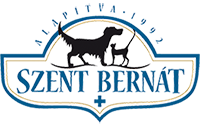Neutered dogs statistically live longer.
Why?
A female dog becomes sexually mature at the age of 7-9 months, i.e. this is when she sheds her first heat. From then on, it will fire roughly every six months.
With each firing, the cervix opens, and there is a risk that bacteria from the vagina will enter the uterine cavity. When the burning is over, the cervix closes and bacteria can multiply in the lumen.
The uterus expands, purulent discharge accumulates in its cavity, pyometra develops.

Toxins absorbed from pus can cause disease in other organs, primarily the liver and kidneys.
The symptoms are:
- increased water consumption
- loss of appetite
- occasionally a reddish vaginal discharge
- vomiting may also occur
What’s the solution?
Most of the time, patients’ lives can only be saved by a well-performed operation – the pus-filled uterus and ovaries must be removed.
It is often necessary to follow-up treatment for a few days after the operation, in which case the patients receive antibiotics, liver protection agents, and, if necessary, an infusion.
How can trouble be prevented?
It is advisable to have dogs not intended for breeding purposes (most of them are) neutered at an early stage.
When should female dogs be spayed?
According to the current state of science, the ideal time for surgery is around the age of the first burn.
For large dogs, it is advisable to wait for the first firing, while for small dogs, the age before the first firing (6-7 months) is recommended. (Due to the increased tendency to bleed, it is not advisable to operate on burning bitches).
At Szent Bernát, due to our professional convictions, we financially support surgeries before puberty.
We offer a 20% discount on the surgery fee for female dogs about to be spayed for the first time!
We often hear:
“The dog must be spayed at least once before neutering”.
There is no scientific argument in favor of this, in fact, research has proven that it is advisable to spay the bitch as soon as possible, it is absolutely not necessary for him to be spayed before the operation!
What about older bitches?
Better sooner than later, but better late than never.
It is never too late to perform sterilization, the risk of pyometra is already excluded with the operation. (Unfortunately, the risk of breast cancer remains even after surgeries performed at an older age).
Of course, euthanizing an older animal, possibly suffering from other diseases, involves a greater risk than a young one. Therefore, a thorough examination of the patient before surgery (laboratory examination, abdominal and cardiac ultrasound) is definitely recommended.
According to our experience, even in the case of a well-examined and prepared patient, there are no more surgical complications than in the case of a young dog.
Unfortunately, we still often hear the misconception (not infrequently from colleagues) that the patient cannot be sedated or operated on because of his age.
An older patient who has been properly examined and is in good condition can indeed be operated on!
How is sterilization done?
The essence of the operation is the removal of the uterus, the hormone-producing organs, i.e. the ovaries (if justified).
Of course, the surgery is performed under anesthesia – in premium conditions at Szent Bernát.
Please see our conditions:
The intervention takes place at an agreed time, and the patients are admitted for surgery after a preliminary examination. Fasting for 6-8 hours is necessary before the operation.
After the operation, the already alert patients are sent home to the owner. (Convenient parking right at the entrance to the surgery).
Dogs that have undergone surgery are provided with a post-operative protective collar or surgical gown to prevent licking of the wound.


In all cases, we take home antibiotics and painkillers, thereby preventing wound infection and the patient’s unreasonable pain.
Suture removal is usually done 10-12 days after the operation. takes place on (Suture removal is free, it is included in the price of the operation).
In the vast majority of cases, the operation is followed by an undisturbed recovery, the operated dogs are active already on the day after the operation.
Of course, the proper protection of the surgical wound and the correct pain relief are important, which we place great emphasis on in every case.
Are there any disadvantages to sterilization?
We often hear the counter-argument that neutered dogs get fat.
It is a fact that neutering slows down the metabolism, but it is not legal for a neutered dog to gain weight. He can only get fat from the food he eats, but the owner can control this very well.
Commercially available (both in our doctor’s office and in our online store) are special, reduced-calorie foods for neutered dogs, which can reduce the risk of obesity even more.
Is your pet not yet sterilized?
Register with him for our free health assessment!
Contacts:
